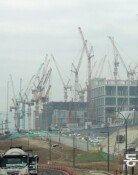Why Are They Flocking to Gaesong? Firms Rushing to the Gaesong Industrial Complex
Why Are They Flocking to Gaesong? Firms Rushing to the Gaesong Industrial Complex
Posted May. 05, 2007 03:02,
Jeong Eul-yeon, CEO of Myungjin Chemical Co. visited the Gaesong Industrial Complex late last month and heard from the Gaesong Industrial Complex Management Committee about low labor costs, land borrowing costs and tax benefits, which are some of the positive aspects of the complex. He expressed great hopes by saying, We will hit it big! However, his lit-up face soon turned grim after looking around the surrounding area.
He was disappointed with the lack of work ethic in the North Korean employees and said, Workers here dont seem to be as hard-working as their Southern neighbors. He was also concerned about the business environment and its safety that is dependent upon the South-North relationship. Jeong, after weighing positive and negative aspects of the complex, finally decided to make investments in it. He still believes there is more to gain than lose.
Why Are They Going to Gaesong?-
An increasing number of SMEs want to invest in the Gaesong Industrial Complex. Approximately 300 business professionals attended the Gaesong Industrial Complex Investment fair, held by the Korea Federation of Small and Medium Businesses (KFSMB) in Yeouido on May 4. Another fair held in Ansan was attended by around 100 business leaders.
Around 22 companies are doing their business at the Gaesong industrial zone. The KFSMB estimates by the end of this year, the number will rise to around 300 even though it predicts the actual number of companies applying to do business will go up even higher. Companies find low labor costs one of the most appealing features the industrial zone offers. While workers at the Gaesong complex are paid 60 USD a month, their South Korean counterparts make 20-30 times more.
Lee Geum-gi, CEO of rope gripper maker Gum Young General Co., said, We have more than 100 people working in a factory in the South, and when the job is done by North Korean workers, well be able to cut costs dramatically. Recent labor cost hikes in China, the country they used to call the Land of Opportunity, are another reason many SMEs are turning to Gaesong. Despite regional differences, the monthly wage of workers in the Chinese coastal areas has increased around two-fold compared to a decade ago to 150-200 USD.
Businesses find the low property borrowing rate and tax benefits appealing. The property-borrowing rate of the Gaesong complex is 149,000 KRW per pyeong, which is much lower than that of Chinas Jinchao Export Processing Zone (app. 450,000 KRW) and Vietnams Danduan Industrial Zone (app. 400,000 KRW). For the first five years of recorded income, companies are exempt from paying corporate taxes and in the three years after that, a 50% cut will be provided. The tax rate is 14%, which is lower than Chinas 25%.
Downside of the Gaesong Industrial Complex
However, the Gaesong Industrial Complex is not free of problems. The biggest concern stems from South-North relations. Whenever the bilateral relationship is strained, South Korean companies in Gaesong are worried about potential damage to their businesses. Indeed, a new complex that was due to open this June was delayed because of the tensions between the two Koreas. North Koreas nuclear issues also put construction on hold for almost a year.
Even with improvements, entry procedures to the North still prove to be a hassle. Goods can move only from 8:30 a.m. to 4 p.m. and commuting is very difficult. Even though it is only 60 km from Seoul to Gaesong, the entry procedures take more than an hour. Regardless, many CEOs of SMEs have high hopes for the industrial complex in Gaesong. Jeong Eul-yeon, CEO of Myungjin Chemical Co., said, I saw four women who had their eyes done, which I believe, means North Koreas market opening has begun. Doing business entails risks to reap the fruits of success.
sanhkim@donga.com







